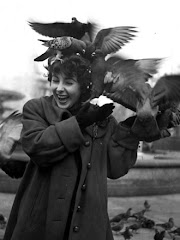
Felder's announcement Monday was somewhat timely, as Nov. 12 was the day we observed Veterans Day, honoring America's wartime heroes. But few remembered that thousands of American and allied forces were saved in World Wars I and II by pigeons. Pigeons?
For centuries, pigeons were used to carry important messages in wartime when communication lines were down, according to Andrew Blechman in his book, "Pigeons: The Fascinating Saga of the World's Most Revered and Reviled Bird."
Blechman recounts one instance of the birds' heroism in the story of the U.S. Army's 77th Division, later known as the Lost Battalion, in World War I. The battalion was trapped behind enemy lines while American troops 25 miles away, unaware of the 77th's position, unleashed a massive artillery attack on them. The desperate soldiers wrote a message: "Our artillery is dropping a barrage on us. For heaven's sake, stop it!" and attached it to their carrier pigeon, Cher Ami.
Blechman writes:
The soldier uncupped his hands and watched the bird flap its wings and gain altitude. The Germans also saw the pigeon and trained their rifles on it. A hail of bullets whizzed through the air and several hit Cher Ami. He quickly lost altitude and plummeted toward the ground. But moments before crashing, the bird somehow managed to spread his wings again and start climbing, higher and higher, until he was out of rifle range.
Twenty minutes later and back on friendly terrain, Cher Ami landed at headquarters. A soldier ran to the bird and found him lying on its back, covered in blood. One eye and part of the cranium had been blown away, and its breast had been ripped open. A silver canister containing the Lost Battalion's desperate plea dangled from a few tendons -- all that remained of the bird's severed leg. Bewildered, the soldier rushed the message to his commanding officer. The American artillery fell silent, and the last remains of the Lost Battalion were saved.
One hundred and ninety-four remaining members of the Lost Battalion were saved that day by a pigeon. Cher Ami died of his war wounds months later, and today can be seen, stuffed, tattered, but still standing on his one leg, at the Smithsonian Institution in Washington, D.C., a testament to the character of the animals so many cities are trying to eliminate.
For centuries, pigeons were used to carry important messages in wartime when communication lines were down, according to Andrew Blechman in his book, "Pigeons: The Fascinating Saga of the World's Most Revered and Reviled Bird."
Blechman recounts one instance of the birds' heroism in the story of the U.S. Army's 77th Division, later known as the Lost Battalion, in World War I. The battalion was trapped behind enemy lines while American troops 25 miles away, unaware of the 77th's position, unleashed a massive artillery attack on them. The desperate soldiers wrote a message: "Our artillery is dropping a barrage on us. For heaven's sake, stop it!" and attached it to their carrier pigeon, Cher Ami.
Blechman writes:
The soldier uncupped his hands and watched the bird flap its wings and gain altitude. The Germans also saw the pigeon and trained their rifles on it. A hail of bullets whizzed through the air and several hit Cher Ami. He quickly lost altitude and plummeted toward the ground. But moments before crashing, the bird somehow managed to spread his wings again and start climbing, higher and higher, until he was out of rifle range.
Twenty minutes later and back on friendly terrain, Cher Ami landed at headquarters. A soldier ran to the bird and found him lying on its back, covered in blood. One eye and part of the cranium had been blown away, and its breast had been ripped open. A silver canister containing the Lost Battalion's desperate plea dangled from a few tendons -- all that remained of the bird's severed leg. Bewildered, the soldier rushed the message to his commanding officer. The American artillery fell silent, and the last remains of the Lost Battalion were saved.
One hundred and ninety-four remaining members of the Lost Battalion were saved that day by a pigeon. Cher Ami died of his war wounds months later, and today can be seen, stuffed, tattered, but still standing on his one leg, at the Smithsonian Institution in Washington, D.C., a testament to the character of the animals so many cities are trying to eliminate.
References:
http://www.homeofheroes.com/wings/part1/3b_cherami.html
http://en.wikipedia.org/wiki/Pigeon_intelligence
http://en.wikipedia.org/wiki/Military_animals
http://www.travelingdogs.com/pigeonsiniraq.html
http://www.homeofheroes.com/wings/part1/3b_cherami.html
http://en.wikipedia.org/wiki/Pigeon_intelligence
http://en.wikipedia.org/wiki/Military_animals
http://www.travelingdogs.com/pigeonsiniraq.html












1 comment:
During WW I a pigeon name CHER AMI saved the lives of some american solders even after he was wounded he flew back to the front and stopped a artillary barage and in WWW II another pigeon named G.I. JOE save some 1000 british solders
Post a Comment